
![]() Historicism
Historicism
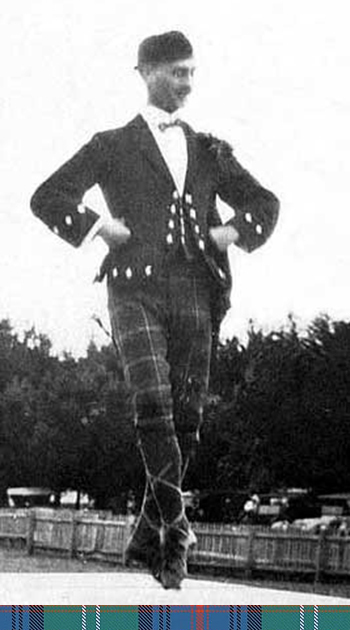
![]() History’s Long Arm
History’s Long Arm
These difficulties with dancing that the Academy and the Piping and Dancing Association are experiencing are an outcome of a particular view of history. A reassessment of that history is being undertaken here and further review of the roles of key individuals in the pantheon is necessary, as has already been done with Ian Cameron and May Thorne Wilson, to whom the memoir is about to return.
The central individuals will be referred to collectively as "the founders", meaning the inner group of influential people in the Piping and Dancing Association and in the Academy from 1945 to 1955. They are important by reason of a deliberate decision they took, in addition to the activities that they are recognised for. The method will continue to be that of political history, considering the interactions of organisations, the place of pipers and the motive force of an idea.
Though their organisation is now the junior player in its partnership with the Pipe Bands Association and the Academy, presidents of the Piping and Dancing Association from 1945 controlled the successful efforts to entrench the Academy in New Zealand but without winning international acceptance of it. Presidents Cameron, Cruden and Nicholson were administrators whose solutions were in terms of rules and regulations - the semi legalistic reaction. Administrative and legal methods are more effective in preventing activities than they are in making things happen.
Having lost control of the Pipe Bands, the presidents' enduring problem was to maintain the Academy in a subservient role to their Association and the constitutions were written to this end. The tactic of control through ex-officio appointments has worked better at some times than it has at others. Presidents were supported in their manoeuvrings with the dancing Academy over a long time by some pipers.
From about 1950, New Zealand pipers have been laying their foundations on Scots granite. Yet almost to a man around this time the pipers on the committees of the Piping and Dancing Association turned from this practice by supporting the dancing Academy in building its castle in the air. The committed support for the dancing Academy of pipers in the Association meetings was organised by Ian Cameron and it was crucial. The strange thing is that they and everyone else knew Mr Sutherland's dancing credentials. Some of the pipers who promoted the Academy in the Piping and Dancing Association meetings tried to maintain a personal relationship with Mr Sutherland. He used to refer to them as those who "Run with the hares and hunt with the hounds". Scots authority was accepted by these men in piping but not in dancing.
Though not a piper, this group later included Percy Geddes who, with others, was to assume the role of historian in finding the supposed roots of the Academy in Scotland and who became an Academy President in a long-sighted move by the Piping and Dancing Association in placing him there ex officio.
![]() Dancing Outpost Argument
Dancing Outpost Argument
It was Percy Geddes who developed and promoted the notion that that the post 1950 style of dance was a remnant, a valuable antique from a long time ago, brought from Scotland to New Zealand where it is preserved and nurtured by the Academy. Apparently it is not known who the dancers were who conveyed the style of dance to New Zealand.
The Geddes notion was central to the raison d’etre of the Academy and the cornerstone of dancers’ beliefs in the Academy style of Highland dancing for about 40 years from, say, 1970.
This memoir does not dispute the fact of the existence of the lines to dancers in Scotland that the genealogists have disinterred. The error is in the interpretation that has been attached to the genealogy. The flaws in the lines to Scotland theory, each of which is terminal to the argument, are: (1) the assumption that those Scots forebears were successful competitive dancers. If they were not competitively successful in the premier Highland games in Scotland then they have no standing as a source of dancing knowledge; (2) Mr Sutherland had impeccable Scots credentials, known to all, that were not utilised; (3) it does not explain why the style came only to New Zealand - how is it that dancers presumably from different parts of Scotland brought a common method of dance just to New Zealand? (4) the establishment of the Academy marked a sharp break about 1950 in the way that New Zealanders danced. There was no evolution from Scotland.
The idea that the dance that the Academy introduced is in a line developed from Scotland has been shown in this memoir to be false. However, it has taken root in ordinary dancers’ minds, as it was intended that it should. It is something of a creation myth for Academy adherents. It surrounds the founders in a glow of adulation. It is the well-spring of New Zealand dancers’ resentment of the Scottish Official Board’s actions. Other reservations that they have are superficialities, a veneer over that construction.
The creation myth has been reinforced by examination among generations of Academy teachers and dancers who are now the rank and file in the New Zealand resistance to the Scottish Official Board. The purpose and the function of the myth and the fact of the break in style that the Academy introduced c. 1950, would have to be explained to them all in order to de-mythologise New Zealand dancing. It would then be possible for the Academy to alter its stance vis a vis the Board.
![]() Historical Revisionism
Historical Revisionism
The history in the March 2015 version of the Academy’s website is notably different from the earlier versions discussed in this memoir. It represents a shift in the Academy’s public position. It is a realignment of the Academy’s public views for national and international audiences. The realignment can be viewed as a retreat from the earlier positions that became untenable as a result of the wide interest in this memoir.
Apart from the excision of the views of its history that the Academy spread in the past, the 2015 Academy website attempts to meet one of the criticisms of earlier editions of this memoir. This criticism is that the Academy has always been bereft of knowledgeable dancers.
The Academy now lists the names of teachers and ex dancers who were key early members of its committees. I knew many of them and remember several of them dancing. Some, such as Muriel Waugh in Christchurch and Gwen McNaughton in Auckland had large dancing schools. The conversion of such teachers brought their considerable numbers of pupils into the Academy, giving it an early presence.
The teachers of just two of this founding group are given, those of May Thorne Wilson and Frances McDougal Cameron. The conspicuous omission in the lists of teachers is that of Mr Sutherland as a teacher of May Thorne Wilson. He taught Muriel Waugh and Coila Barrowman Richardson as well. We still don’t know who taught the others listed. Their teachers, other than that of Dorothy Parker, one assumes were non entities, otherwise they would be publicised.
The singular fact of these listed Academy people is the timing of their change in style of dancing and the in style of dancing that they taught their pupils. One had to be a member of the Academy before one could gain influence in it. Members had to change their style of dancing and teaching in order to become members of the Academy elite. Coila Barrowman Richardson, June Scott and Margaret Laurenson are examples. One could not be a member of the Academy elite and be a Sutherland style dancer.
Only Academy aficionados were permitted to deliberate on Academy dancing. It was circle that was thereby closed to proper dancing knowledge. Bertie Robertson experienced this encirclement. Consequently, it should not be thought that several people on the list brought proper dancing knowledge to the Academy forum. It was necessary for them to be an Academy adherent or teacher before they could join the Academy hierarchy and gain influence.
The assertions, made in the 2015 Academy website, that there were knowledgeable dancers involved in the development of Academy dance fail because such knowledge as some them may have had was never operational within the Academy. The Academy has all of difficulties that are associated with policies of deliberate isolation. Art does not thrive when isolated and, as we have seen, Academy dancers are isolated.
 |
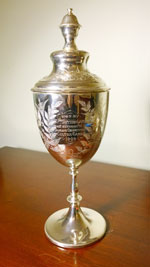 |
|---|---|
| Ellon Games 1912 Special Prize for Dancing |
Won by Wm Sutherland most successful in Dancing Competition Culter Games 1909 |
One issue that arises is why the Academy has had differing versions over time of its own story. The first phase of the Academy was the brute force of the registration systems for dancers, judges and sports meetings. This was buttressed by the threat of expulsion of the non-registered, and it was used to enforce its synthetic dancing style. This was necessary in the early period of its existence because there were too many people alive who knew how the Academy developed and proceeded for it to succeed by anything but administrative force.
The second view of its history was the outpost story of a long lost Scottish style of dancing surviving only in New Zealand and protected by the Academy. This myth was heavily emphasised for many years after William Sutherland’s death. This notion was exploded by this memoir so the Academy had to move to its third and current version of its history for public consumption. The 2015 Academy website maintains that there is a unique style of New Zealand Highland dancing. This understatement immediately involves the problem of the source of this unique New Zealand style.
To resolve the source problem, in its 2015 attempt the Academy goes on to argue that the Academy style was laid down by May Thorne Wilson and Frances Cameron. There is a grain of truth to this assertion but it is only a grain for the reasons developed below. The new emphasis given to Ms Wilson and Ms Cameron contradicts and negates the previous expositions of the Academy’s views of its history.
The previous view, developed by Percy Geddes, was that a group of “dancies” brought the style to New Zealand, and to New Zealand alone, from Scotland.
This change in its official history is a reversal for the Academy for which the arguments of this memoir have proven decisive. However, the reversal leaves Academy adherents wondering about the reliability of the versions of history that they receive and the integrity of the Academy.
![]() Frances Cameron
Frances Cameron
We must run now to another of the founders. May Thorne Wilson has already been discussed in this memoir so we turn to Frances (Fassie) McDougal Cameron. She was Ian D Cameron’s wife. He appointed her as head of the Technical Committee of Dancing. A bald case of nepotism, and seen this way at the time a fact no longer mentioned, her appointment is an indicator of Ian D’s techniques of control.
The Academy lists Fassie’s several teachers. One of them is a piper and another, Bob Haddow, learned dancing from a Pipe Major Taylor. Their piping antecedents do not inspire confidence in the dancing that they putatively transferred to Fassie.
I remember Bob Haddow as a hard line Academy judge of dancing at minor sports meetings in the Manawatu and Horowhenua prior to 1950. He has no dancing record of note in Scotland. He can have had little to pass on to Fassie or to the Academy of which he was the first President. His appointment would have been arranged by Ian D. Cameron.
Duncan MacLennan is also on the quite long list of Fassie’s teachers. Duncan was one of the London MacLennan dancers discussed in the Introduction and again in the section on his pupil, Dorothy Parker, (see Academy Beginnings).
Fassie went to Scotland in 1924 where she had dancing lessons from some on the list of her teachers. She appears to have been there for less than a year and had more than one teacher there. None of her teachers, including MacLennan, has a respectable record in Scotland so they were not great dancers, though there was a dancer named Darge (Dargie?) who was not unknown.
Also germane to our argument, Fassie herself appears not to have competed in Scotland, though May Thorne Wilson did so about this time. Nothing of Mrs Cameron’s New Zealand dancing record appears on the Academy website either, though I do know that she won some prizes here. Little is known of any pupils of Fassie’s. Available evidence does not point to her being a dancer of consequence or of her being taught by a dancer of stature. This assessment is supported by May Thorne Wilson’s jaundiced view of her dancing knowledge.
A further fact about Fassie is that she was never a presence at the sports meetings, not even the ones near her home in the Waiararapa. I competed at all of the Waiararapa meets for over a decade from 1944 and the main ones further afield for longer. She was not at them.
Fassie McDougal Cameron is a principle feature of the history section of the Academy’s 2015 website. Other administrators have been treated in other parts of the memoir. She chaired the Technical Committee. She is one of the people who is now meant to authenticate the Academy style of dancing. She does not appear as an adequate platform for the edifice that is the Academy. The previous versions of Academy history have been expunged from the website.
It was noticed earlier that there is a germ of truth in the Academy’s website assertion that May Thorne and Fassie Cameron laid down the principles of Academy dancing. The grain of truth is that the two women were influential figures early in the Academy movement. The whole truth is different.
The “How it Began” section of the Academy website (6 March 2015) states that,
Basic techniques were laid down by Mesdames Wilson and Cameron…our art has evolved from impeccable sources.
We now show why this is an unreliable viewpoint. Our argument partitions into three segments. Foremost, there was an impeccable source available in New Zealand that the Academy ignored. That source was William Sutherland whose dancing record is second to none (see Dancing Record).
The claim of impeccable sources, were it true, ignores the dynamics of the Academy meetings and where in them that the power lay. The numbers of people cited as contributors and the tenor of the historical portion of the Academy website may leave the impression that there were reasoned discussions on points of dancing technique at Academy meetings.
We have seen already how Ian Cameron was an adroit organiser of the outcome of meetings before the event. (See Academy Beginnings). We know that May Thorne Wilson was disgruntled with Fassie Cameron’s lack of dancing knowledge to the extent that Wilson withdrew for a period in the early days of the Academy. (See Academy Beginnings).
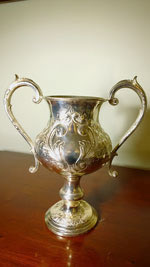
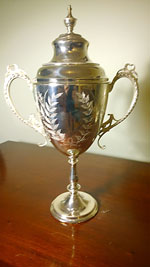
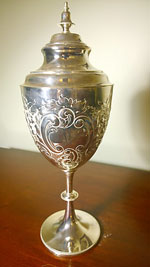
It is also known from May Thorne’s breakfast meetings with Mr Sutherland that not only did she think Mrs Cameron’s dancing knowledge to be insufficient but that the atmosphere in the early Academy meetings was intemperate. Bruce McCann was a member of the Piping and Dancing Association Wellington Centre for years from the late 1940’s and attended its tempestuous meetings. I understand that vituperation has flared in relatively recent Academy meetings. This was the committee culture that Ian D Cameron allowed, nay fostered.
A smooth process of the handing down of technique by two women from on high, implied by the Academy website, is thus an unreliable interpretation of the developmental process. From May Thorne Wilson’s conversations with Mr. Sutherland we know that it did not happen. (See Academy Beginnings.) The artificial Academy style of dance that emerged in the early years is most likely to have originated partly with the inadequate Fassie Cameron and to have been passed in torrid meetings by her supporters who were so placed by Ian D. Cameron.
![]() Dorothy Parker
Dorothy Parker
The final segment of the case against the two important women idea is that it is further falsified because there were three. The Academy website supresses the importance of Dorothy Parker who had a major influence on style. Ms Parker’s connections to the London MacLennans and the MacLennan’s strong connections with ballet have been discussed in other chapters in detail. What is of great importance now is that Dorothy Parker was the vehicle by which ballet techniques were transported into Academy dancing. One concedes that Fassie may have acquired some ballet technique in Scotland from Duncan MacLennan but she could not have been with him there for very long. May Thorne Wilson and Frances Cameron had little by way of ballet training so they we not the vehicles.
Dorothy Parker learned several forms of dance from the same Duncan MacLennan in Gisborne over a period of two or three years. These included Highland, ballet and Spanish dancing. She was also one of the Academy’s inner group for a long period from its early days. Her influence is seen in the way that several movements are performed by Academy dancers. The back beat, the shakes, swings and even the elementary first position are clear examples of ballet techniques which she imported from ballet.
The mistake that Dorothy Parker made was with the music of Highland dancing. Her movements were not new, they have long been a part of Highland dancing, but after her they were timed in a different way in New Zealand. She had them danced in the ballet style where the tempo, timing, phrasing and rhythms generally of the music are quite different from those of bagpipe music. This, as much as any single thing changed the nature of Highland dancing in New Zealand. Incidentally, I do believe that the way that Academy dancers time those movements has affected the way that pipers play dance tunes to Academy dancers in competitions.
These errors of Dorothy Parker’s were profound and struck the beating heart of Highland dancing. She did not understand bagpipe music and the phrasing of the pipe tunes for Highland dancing. A dancer lacking this knowledge is degenerate. The scars that Dorothy Parker left were visible in Academy dancing from her day to this.
The Academy’s already cited assertion that ... our art evolved from impeccable sources does not withstand scrutiny. Academy dancing is the product of a cabal. It is artificial, contrived and has no originating tradition. It is wrongly claimed that there were two women principals when there were three. They are claimed to have had impeccable teaching lines from Scotland. Were that true, they would not have set down a style so different from the Scottish style of Highland dancing.
The changing story of the Academy calls for examination. Why does the Academy from time to time change its version of its own history? The answer to this fundamental question is to be found in the underlying falsehood that the organization rests upon. This falsehood is the artificial dancing style that the Academy invented for itself. This unsafe foundation shifts, shaking the Academy’s intellectual structure, and a new version of history is issued. The periodic historical revisions leave past Academy dancers, who believed the different Academy creation myths, without a story and with questions about the truth.
Earlier versions of this memoir have rendered untenable the Academy’s endeavours to find an historical justification for itself. The memoir has destroyed the academy’s attempts to authenticate the internationally outlawed style of Highland dancing that it developed and that it still promulgates.
As each justification has been falsified, the Academy has attempted to justify itself anew to its members with a fresh fabrication. The 2015 Academy edition of its history, in which Mrs Thorne Wilson and Mrs McDougal Cameron jointly handed down the style, ex cathedra, is false too. They were at loggerheads and there was a third, equally important, woman.
![]() Enduring Opposition
Enduring Opposition
The directed and differing histories of the Academy that have been developed, selectively writes out of the record the undeviating and enduring opposition to the Academy dancing style of the only expert dancer in New Zealand, William Sutherland. Their official story asserts the excellence and the knowledge of the local dancers who developed the Academy method of dancing, yet who really had no dancing education other than from their likewise untutored teachers. The received version of that history, written by those effectively unschooled in dancing, tries to break this cycle of ignorance by tracking this teaching to largely inexpert dancers from Scotland.
Here we have the reason for the excision from the record that May Thorne Wilson was Mr Sutherland's dancing pupil. It would have been a non-sequitur to connect her to his Scottish authority when he was so opposed to the methods that she helped to introduce through the Academy. All the writers of the history could do was to suppress her connection to him, and they did so.
The slanted history acknowledges Mr Sutherland’s record in Scotland in a cursory manner yet he was a major presence, for a long time, in each country. This point is not developed at all in what is called the “history”. His ostracism and its consequences are not a part of the Academy’s preferred story.
Sending Mr Sutherland to Coventry offers a major insight into the Piping and Dancing Association’s and the Academy founders’ interest in dancing. They are held to be farsighted developers when actually they excluded the man who could have helped them, from both organisations. The few of Mr Sutherland’s ex-pupils who were involved at different times had essentially no influence for much the same reasons. The same is true of Davey Bothwell and Bert Robertson. All of those people were absorbed and neutralised.
The deliberate decision that the founders made from the outset was to exclude Mr Sutherland from the Academy. This ostracism of Mr Sutherland at the very beginning has led to today’s difficulties. There has been a suppression of that critical fact. It is central to the understanding of the politics of, and in understanding the techniques of, and in evaluating the contribution of the founders to, the New Zealand Academy of Highland and National Dancing today.
The founders had decided to redirect the course of New Zealand Highland dancing. The logic of their attitude towards Mr Sutherland was, almost as a necessary progression, extended to an antipathy towards the Scottish Official Board. By the mid 1950s the founders had a difficult situation of their own making on their hands. They were prevented from comprehending or adequately responding to the signals that they were getting from the Board by their predetermined position on an artificial dancing method. A reassessment of the founders’ mindset, their personal objectives and their worldview appears necessary on these issues.
It is very important to realise that Mr Sutherland’s immediate opposition was to the dancing techniques that were being introduced. That opposition always remained and later extended to the Academy itself, as the organisation that enforced them. The so-called roots of the Academy method in Scotland were revealed for local consumption in part as a response to New Zealanders who were influenced by the pressure that the Scottish Official Board was exerting. Another reason behind the development of the false history was the long run necessity for the members of an organisation to see it as legitimate.
Had the Academy truly had direct lines to competitors of repute in Scotland it would have proclaimed them during its beginnings. For example, May Thorne Wilson’s connection to Mr Sutherland was used in this way until he made it untenable, as we have seen. The Academy made no such other serious claim in its formative period nor indeed at any time before 1960. It was some time after that date that these claims appeared. The immediate issue is why the claimed Scottish origins of Academy dancing took so long to emerge.
The effect of my own dancing enters here as a part of the reason for the long delay in the appearance of the roots in Scotland argument. I was actively dancing all around the North Island, and occasionally in the South, from 1944 until about 1960. There was interest around the boards in the way that I danced. It advertised Mr Sutherland’s rejection of the Academy. The Academy could not lay a claim to a Scottish derivation with Mr Sutherland’s pupil performing before everyone and demonstrating the contrast. The construction of links to Scotland would become possible only as Mr Sutherland passed from the scene. This is why it was so long delayed.
The Academy developed and relied on an erroneous view of the history of Highland dancing in New Zealand, which has had the effect of justifying the implementation of the Academy’s dancing technique. This interpretation was adopted by policy makers in the Piping and Dancing Association and the Academy from about 1970, or in any event after Mr Sutherland’s death. That interpretation (and consequently its subsequent use) can be clearly demonstrated.
That official view of history is now restricting the Academy's available options in trying to deal with the Scottish Official Board. To modify this policy would be to deny the history that the Academy and the Association have disseminated to decades of their members, who have received it in good faith. The Pipers and Dancers Association and the Academy are now the prisoners of the history that they wrote. Responsibility for the capture of the two organisations by the rewritten history lies with the policy makers in them both since about 1970.
The generic issue to which this memoir seems always to return is, “Who taught Jane Doe Highland dancing?” As Mr Sutherland used to say in his soft Highland accent, the answer to that rhetorical question usually is, “Peter learned from Paul and Paul learned from Andrew but Andrew never knew it in the first place”. And there is the whole problem of the Academy today.
A dancing life is a short one and the Academy has damaged generations of dancers for over 60 years. I really doubt that New Zealand dancing can recover from all of this because the root and branch pruning of a tree has effects that remain as long as it lives.